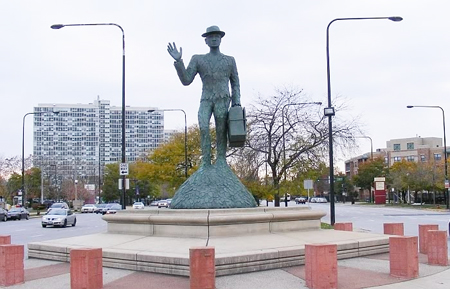
Bronzeville is the neighborhood roughly bordered by the Dan Ryan Expressway on the east, Cottage Grove on the west, 26th Street on the north, and 51st Street on the south. In the early 20th century, Bronzeville was also known as the Black Metropolis, the destination of many Blacks who sought to escape the South during the Great Migration. The neighborhood thrived as Chicago’s Black epicenter because of racial segregation and the Black population explosion that accompanied the Great Migration.
That need for goods and services created a local Black economy which was basically self-reliant. The Black Metropolis relied on the interconnectedness of the business, political, and service communities. The businessmen in Bronzeville worked to elect politicians that allowed their businesses to thrive. Conversely, those businessmen were also local philanthropists who gave back to the community, created local institutions and provided assistance.
Bronzeville was once the home of The Regal Theatre, The Parkway Ballroom, The Sunset Café and the Dreamland Café, where any number of famous Black entertainers would perform. Bronzeville was also home for some of Black America’s most storied figures, including: Gwendolyn Brooks, Sam Cooke, and Lou Rawls. Even famed trumpeter Louis Armstrong spent some time perfecting his craft in Bronzeville.
From the 1940’s through the 1960’s, significant concentrations of public housing projects were built in the Bronzeville community. The Robert Taylor Homes, Stateway Gardens, and Dearborn Homes, combined with the Harold Ickes Homes and the Hillard Homes formed the infamous Chicago Housing Authority State Street Corridor. The State Street Corridor was the largest, continuous stretch of public housing projects in the country. Some would also argue that the State Street corridor was constructed by then Mayor Richard J. Daley as a natural racial barrier, along with the Dan Ryan, to keep Blacks contained east of the expressway. Whether intentional or not, the result was one of the largest concentrations of crime and poverty the country had ever seen.
As a result, what was once the Black Metropolis became a black hole of poverty and despair, with immigrant groups taking control of the retail business that was once controlled by Black businessmen. The insurance agencies, banks, and theaters were replaced with liquor stores, nail shops and fried chicken joints. The Bronzeville that was once the center of Black life in Chicago had become the place Black people sought to avoid. Bronzeville has essentially become “The Low End.”
Though Bronzeville boasts a rich history of uplifting and supporting the Black community, the long term deterioration of the once thriving neighborhood, has left land and capital up for grabs. Now the question is, will Bronzeville be able to return to its former glory without pushing out the people who helped to build it.
As a result, what was once the Black Metropolis became a black hole of poverty and despair, with immigrant groups taking control of the retail business that was once controlled by Black businessmen. The insurance agencies, banks, and theaters were replaced with liquor stores, nail shops and fried chicken joints. The Bronzeville that was once the center of Black life in Chicago had become the place Black people sought to avoid. Bronzeville has essentially become “The Low End.”
Though Bronzeville boasts a rich history of uplifting and supporting the Black community, the long term deterioration of the once thriving neighborhood, has left land and capital up for grabs. Now the question is, will Bronzeville be able to return to its former glory without pushing out the people who helped to build it.
Bronzeville was contained wholly in the third ward, and the most prom- inent figure in the Third Ward was Black activist and civil rights leader turned politician, Alderman Dorothy Wright Tillman, affectionately known as “The Hat.” Appointed in 1985 as part of the Harold Washington movement, Tillman was known as an unabashed champion for Black people, poor Black people in particular. Because Tillman’s ward contained the highest concentration of poor Blacks, it only made sense that she advocated for poor Blacks; but Tillman was also a historian, and the history of Bronzeville as the Black Metropolis was not lost on her. So she began implementing a 70/30 plan, which meant that 70 percent of the business and jobs in the community would go to Black people. But to Tillman, ownership was the key.
“I wanted our people to be able to stay in our community. I did not want them to leave because they had to, but because they wanted to,” Tillman said. “We were redeveloping Bronzeville, really Grand Boulevard, with Black people benefitting. We wanted to build our community off of our strengths, which were the arts,” she continued. “If you go to Chinatown they sell you on the rice; I wanted people to come to Grand Boulevard and be able to hear our music and see our culture. I wanted to mark our community.”
But Tillman was not able to complete her plan because Pat Dowell defeated her during bitterly fought election in 2007. Dowell, who touted her credentials as an urban planner during the campaign, was faced with the unenviable task of picking up the redevelopment of Bronzeville after Tillman. Dowell was able to capitalize on the changing demographics of the Third Ward to oust Tillman, whose actions were seemingly misinterpreted.”
“I wanted our people to be able to stay in our community. I did not want them to leave because they had to, but because they wanted to,” Tillman said. “We were redeveloping Bronzeville, really Grand Boulevard, with Black people benefitting. We wanted to build our community off of our strengths, which were the arts,” she continued. “If you go to Chinatown they sell you on the rice; I wanted people to come to Grand Boulevard and be able to hear our music and see our culture. I wanted to mark our community.”
But Tillman was not able to complete her plan because Pat Dowell defeated her during bitterly fought election in 2007. Dowell, who touted her credentials as an urban planner during the campaign, was faced with the unenviable task of picking up the redevelopment of Bronzeville after Tillman. Dowell was able to capitalize on the changing demographics of the Third Ward to oust Tillman, whose actions were seemingly misinterpreted.”
“People like to say ‘Doro- thy Tillman took all the land’ but I really put it on hold, so when those White people would come, they would have to [talk] to me about Black ownership. At that time Black politicians controlled 90 percent of the available land in the city. I wanted that land so you could come home,” Tillman emphasized.
As the CHA implemented its “Plan for Transformation” large blocks of Tillman’s most loyal supporters in the housing projects were jettisoned to far off suburbs via Section 8. In their place, equally tall South Loop skyscrapers were built, but they were filled with more wealthy tenants who had different priorities, who some Bronzeville residents think Dowell caters to, a claim she denies.
“I prioritize all the communities in my ward, but the needs are different. In the Bronzeville community, public safety issues like drug sales, shootings and violence are big issues. In the South Loop there are more issues like loitering and burglaries. The needs are just different!” Dowell emphasizes. caters to, a claim she denies.
As the CHA implemented its “Plan for Transformation” large blocks of Tillman’s most loyal supporters in the housing projects were jettisoned to far off suburbs via Section 8. In their place, equally tall South Loop skyscrapers were built, but they were filled with more wealthy tenants who had different priorities, who some Bronzeville residents think Dowell caters to, a claim she denies.
“I prioritize all the communities in my ward, but the needs are different. In the Bronzeville community, public safety issues like drug sales, shootings and violence are big issues. In the South Loop there are more issues like loitering and burglaries. The needs are just different!” Dowell emphasizes. caters to, a claim she denies.
“I prioritize all the communities in my ward, but the needs are different. In the Bronzeville community, public safety issues like drug sales, shoot- ings and violence are big issues. In the South Loop there are more issues like loitering and burglaries. The needs are just different!” Dowell said.
There is no doubt that the third ward is growing, but where Bronzeville fits in that growth depends on whom you ask. There are those that are new to the Bronzeville area, hoping it will be the next big Chicago neighborhood to explode. The number of upwardly mobile Black and white families that continue to buy homes in the neighborhood evidences this. As you drive down certain blocks, it becomes apparent that Bronzeville has tremendous potential, but it is also on those same blocks that Hadiya Pendleton was killed after school in a park. The dichotomy of Bronzeville is real.
Art galleries exist just steps away from where armed robberies occur. Mariano’s is opening up just blocks from 200 Liquors, which was the “al- most” grocery store inside a liquor store. Peach’s and H-Dogs are located on the same 47th Street strip as Maggie’s Gyros. Bronzeville is two communities trying to figure out how to become one, but at whose expense?
There is no doubt that the third ward is growing, but where Bronzeville fits in that growth depends on whom you ask. There are those that are new to the Bronzeville area, hoping it will be the next big Chicago neighborhood to explode. The number of upwardly mobile Black and white families that continue to buy homes in the neighborhood evidences this. As you drive down certain blocks, it becomes apparent that Bronzeville has tremendous potential, but it is also on those same blocks that Hadiya Pendleton was killed after school in a park. The dichotomy of Bronzeville is real.
Art galleries exist just steps away from where armed robberies occur. Mariano’s is opening up just blocks from 200 Liquors, which was the “al- most” grocery store inside a liquor store. Peach’s and H-Dogs are located on the same 47th Street strip as Maggie’s Gyros. Bronzeville is two communities trying to figure out how to become one, but at whose expense?
According to Dowell, things are looking up because, “retailers make decisions based on income and demographics. I believe that the new Mariano’s will be a catalyst to spur development in the area.”
She also points to the development of a new 25,000 square foot development that is set to open across the street from Mariano’s.
Historically gentrification means that people of color are forced out of a community. While it sometimes requires convincing, it is generally not difficult to encourage Black residents to move, particularly if they rent or live in subsidized housing, which was something that Tillman said she fought to protect.
“I fought hard to save public housing,” Tillman emphasizes, “to bring our community up.”
Alderman Dowell has also taken on the public housing challenge by moving forward with the massive Carol Rosenwald project, that Dowell hopes will create 239 units of housing for seniors and working families. Dowell also says she hopes to bring commercial development, retail, a restaurant and a coffee shop to what was one of the most infamous corners in Bronzeville.
Ironically, the Rosenwald project is the perfect metaphor for Bronzeville. The Rosenwald has a long history in the Black community, and not all of it is positive. As Alderman Dowell seeks to rebuild the Rosenwald proj
ect, she must keep just the history and nostalgia while combining it with a new vision to be successful. The same goes for Bronzeville.
She also points to the development of a new 25,000 square foot development that is set to open across the street from Mariano’s.
Historically gentrification means that people of color are forced out of a community. While it sometimes requires convincing, it is generally not difficult to encourage Black residents to move, particularly if they rent or live in subsidized housing, which was something that Tillman said she fought to protect.
“I fought hard to save public housing,” Tillman emphasizes, “to bring our community up.”
Alderman Dowell has also taken on the public housing challenge by moving forward with the massive Carol Rosenwald project, that Dowell hopes will create 239 units of housing for seniors and working families. Dowell also says she hopes to bring commercial development, retail, a restaurant and a coffee shop to what was one of the most infamous corners in Bronzeville.
Ironically, the Rosenwald project is the perfect metaphor for Bronzeville. The Rosenwald has a long history in the Black community, and not all of it is positive. As Alderman Dowell seeks to rebuild the Rosenwald proj
ect, she must keep just the history and nostalgia while combining it with a new vision to be successful. The same goes for Bronzeville.




